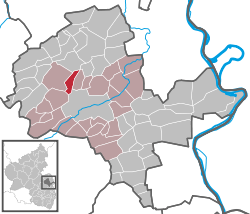Bornheim (Rheinhessen)
Bornheim is an Ortsgemeinde – a municipality belonging to a Verbandsgemeinde, a kind of collective municipality – in the Alzey-Worms district in Rhineland-Palatinate, Germany. It is known as the "Gateway to the Rhenish-Hessian Switzerland", as the region is called.
Bornheim | |
|---|---|
.png) Coat of arms | |
Location of Bornheim within Alzey-Worms district  | |
 Bornheim  Bornheim | |
| Coordinates: 49°46′59″N 8°3′37″E | |
| Country | Germany |
| State | Rhineland-Palatinate |
| District | Alzey-Worms |
| Municipal assoc. | Alzey-Land |
| Government | |
| • Mayor | Bernhard Beck |
| Area | |
| • Total | 4.45 km2 (1.72 sq mi) |
| Elevation | 177 m (581 ft) |
| Population (2018-12-31)[1] | |
| • Total | 922 |
| • Density | 210/km2 (540/sq mi) |
| Time zone | CET/CEST (UTC+1/+2) |
| Postal codes | 55237 |
| Dialling codes | 06734 |
| Vehicle registration | AZ |
Geography
Location
Bornheim is nestled in a hollow, sheltered by the Oswaldshöhe (heights). The municipality lies in Rhenish Hesse.
Its main winemaking appellation – Weingroßlage – is Adelberg.
History
In 767 or 768, Bornheim had its first documentary mention in a donation document from Lorsch Abbey. Archaeological finds, however, make it clear that the village existed earlier. Graves for cremated remains and a Frankish row graveyard from about AD 500 have been found in the municipality. The Oswaldshöhe is thought to have served as an early gathering place for Germanic peoples.
The church was first mentioned in 1241 and partly destroyed by French troops in 1690. The tower with its wall paintings from the 13th century, however, remained standing. It also houses Rhenish Hesse’s oldest bell.
Like the surrounding municipalities, Bornheim belonged to the Waldgraves in the Early Middle Ages, and beginning in 1671 to their kin, the Rheingrafen (“Rhine Counts”). After the Napoleonic Wars, the municipality passed, as part of Rhenish Hesse, to the Grand Duchy of Hesse-Darmstadt.
On 31 December 1871, the railway arrived. Passenger service on the Armsheim - Bornheim - Flonheim - Wendelsheim line (Wiesbachtalbahn), though, was ended in 1966, and since then the line has been completely abandoned.
After the First World War, French troops built a munitions depot right next to the railway line.
In the Second World War, several bombs fell in the local area, which luckily did no great damage.
After 1961, Bornheim became known as the “Village of Roses and Wine”. At this time, 5,000 climbing roses were planted. This was surely the reason why in 1973, at the national level, the municipality won gold in the contest Unser Dorf soll schöner werden (“Our village should become lovelier”), and was long said to be Rhenish Hesse’s prettiest municipality.
The municipality’s favourable location for transport, having its own interchange on the A 61, and the affordable property prices have led to quick growth over the last few years, such that there are now 825 inhabitants (as at 31 December 2006).
Politics
Municipal council
The council is made up of 12 council members, who are elected by majority vote, and the honorary mayor as chairman.[2]
Mayor
- Bernhard Beck (2004–present)
Culture and sightseeing
Buildings
- Church, tower from about 1200, with wall paintings from the 13th century, and Stumm organ (music)
- Village fountain
- Old well pump
Economy and infrastructure
Transport
- Bornheim Autobahn interchange (A 61)
- Landesstraße (state road) 408
References
- "Bevölkerungsstand 2018 - Gemeindeebene". Statistisches Landesamt Rheinland-Pfalz (in German). 2019.
- Kommunalwahl Rheinland-Pfalz 2009, Gemeinderat
External links
- Municipality’s official webpage (in German)
- Bornheim in the collective municipality’s Web pages (in German)